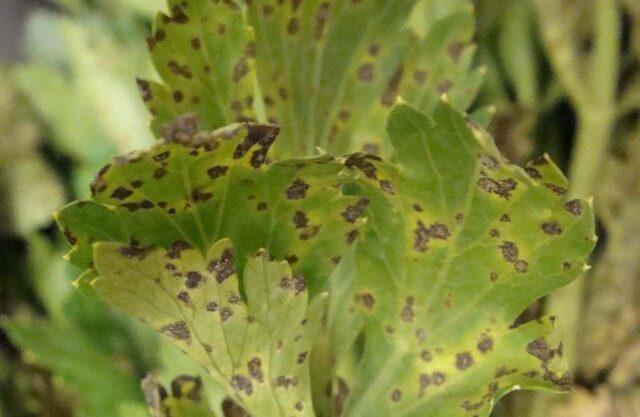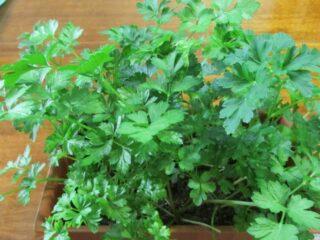Lush, vibrant greenery is one of the main signs of healthy plants in the garden. Therefore, if the parsley in the garden turns yellow, there is clearly something wrong with it. It is quite possible to restore its “presentable appearance”, especially if the problem is noticed at an early stage of development. But for this you need to correctly establish the cause.
Why does parsley turn yellow in the garden?
When the parsley in the garden begins to turn yellow, you need to carefully examine the plants and analyze your own actions to care for them. There are not so many reasons for the deterioration of its appearance; identifying the problem will not be difficult even for not very experienced gardeners.
Improper watering
In most cases, parsley begins to turn yellow due to improper watering. This is a fairly moisture-loving crop, deterioration in appearance, withering leaves are a natural reaction to prolonged heat (temperatures above 28-30 ° C) and drought.
Greens can also turn yellow due to regular waterlogging of the soil in the garden.Under such conditions, the roots almost inevitably begin to rot; they are no longer able to provide the above-ground part with nutrients in the required volume.

When parsley turns yellow due to improper watering, not only its “marketable appearance” disappears, the leaves become hard, almost tasteless
To prevent the leaves from turning yellow, it is watered, taking into account the air temperature outside, the frequency and abundance of precipitation. On average, twice a week is enough (5 l/m²), but in hot weather the substrate is moistened daily. You need to focus on the condition of the parsley leaves - water the bed when they wither slightly.
Nutrient deficiencies
When there is a deficiency of nutrients in the soil, parsley quickly turns yellow. The reasons for their shortage are either the gradual “depletion” of the soil or planting seeds in initially “poor” soil in the absence of fertilizing, or neglect of weeding.
If a gardener regularly weeds and feeds parsley, but it still turns yellow, you need to check the pH of the soil. When it is highly acidified, it reduces the ability of plants to “pull” nutrients from the soil and absorb them in full.

Excess fertilizer for parsley is also harmful; nitrates quickly accumulate in the greens
Diseases
Most often, parsley turns yellow due to pathogenic fungi. But viruses can also attack it.There are no means of combating them yet; the affected plants can only be pulled out and destroyed.
Powdery mildew
The activation of the fungus is promoted by high temperature and high humidity. A powdery grayish or whitish coating appears on the stems and leaves, reminiscent of spilled flour. Gradually it “compacts”, turning into a continuous layer, changing color to lilac-gray. Tissues affected by the fungus turn yellow and rot.

Powdery mildew spreads throughout the plant from the bottom up; in most cases, parsley becomes infected through leaves touching the ground
Rust
The leaves and stems are covered with numerous small saffron spots with a “hairy” surface. They grow quickly and change color to rusty brown. The affected parts of the plants turn yellow, dry out and die.

Coniferous plants often become “intermediate hosts” of rust.
Septoria
One of the most dangerous diseases, typical not only for parsley, but also for any Umbelliferae. Develops most often in mid-summer. Light green spots with a beige border appear on the leaves. They gradually change shade to grayish-white, the edging to brown. The tissue around these spots turns yellow.

The “folk” name - “white spotting” - accurately indicates the main symptom of septoria parsley
Alternaria blight
Aka “early burn”. The leaves do not turn completely yellow; they become covered with small “speckles.” These spots quickly turn brown, then lighten almost to transparency.

Parsley affected by Alternaria completely dries out and dies by mid-summer
Stolbur
Viral disease. The lower leaves first turn yellow, then turn red.The plant practically stops developing, the greens completely lose their characteristic taste and aroma.

The main carriers of stolbur are cicadas, so the disease appears towards the end of summer
Pests
Due to the high concentration of essential oils, parsley is “inedible” for many pests, but there are exceptions. The list of “potential enemies” is short, and it is not difficult to “identify” them.
Aphid
A very common pest from the piercing-sucking category, dangerous for most garden crops. It is difficult not to notice small insects of pale green or black-brown color. Aphids “invade” the plant in entire colonies and feed on its sap. Affected leaves and stems first turn yellow, then become discolored to translucent, dry out and die.

Aphids concentrate mainly on the most tender, young leaves of parsley
carrot fly
Adults are small (about 5 mm), orange-yellow and black flies. Females lay eggs in the soil at the base of the rosette, and the hatching larvae “gnaw” the roots. The above-ground part, which does not receive sufficient nutrition, turns yellow and withers.

The carrot fly becomes more active when the air and soil humidity are high.
psyllid
Both adults (small light green insects) and larvae (yellow-green caterpillars) feed on parsley juice. A plant experiencing a deficiency of nutrients and problems with photosynthesis practically does not develop, turns yellow and dies.

Parsley leaves affected by psyllid not only turn yellow - they almost completely lose their characteristic taste and aroma
Stem nematode
Translucent “worms” that live in the soil. They penetrate the roots through existing external microdamages and gradually rise up the stem.Nematodes chew out tissues from the inside, poisoning them with waste products. It slows down in growth, the leaves turn yellow and curl.

If nothing is done, the parsley bushes affected by the nematode will rot and die.
What to do with yellowed parsley
The measures taken to “restore the health” of parsley directly depend on the reason that caused the deterioration in the appearance of the plant. You will have to either reconsider your care or specifically combat pests or pathogens.
Treatment against pests and diseases
If parsley leaves turn yellow due to disease, it is necessary to treat it with antifungal drugs, after cutting off all leaves and stems affected by the pathogen. It is better to get rid of heavily infected specimens immediately.
When the disease is noticed at the beginning of its development, folk remedies and drugs of biological origin are often enough. A solution of potassium permanganate, baking soda and soda ash, kefir or whey diluted with water have an antifungal effect. Their significant advantage is the possibility of application at any stage of plant development.
In “severe cases,” any fungicides are used. But after processing, parsley cannot be cut for food for a certain period of time.

Copper-containing preparations are harmful to fungi
To prevent parsley from turning yellow, spray not only the greenery with a suitable product or preparation, but also the soil in the flowerbed, after watering it. To cope with the disease, 2-3 treatments with an interval of 10-12 days are usually enough.
Insects that attack parsley do not like strong odors. If there are not many of them in the beds yet, you can spray the plantings with “fragrant” infusions.Onion and garlic “feathers”, pine needles, citrus peels, and any herbs are used as “raw materials”. When the pest that causes the leaves to turn yellow has multiplied en masse, the parsley bed is treated with universal insecticides. The concentration of the solution and the frequency of treatments are determined in the instructions.
What to feed
Parsley reacts positively to both mineral and humic store-bought fertilizers and folk remedies. Therefore, it is recommended to alternate them. Most often in spring the leaves turn yellow due to a lack of nitrogen. To “make up for the deficiency,” in addition to store-bought mineral fertilizers, you can use infusions of manure, bird droppings, and “green tea” from weeds.
During the season, parsley needs complex fertilizing, which must contain potassium and phosphorus, so that it does not turn yellow. Both store-bought preparations and folk remedies (infusion of yeast, black bread, banana peel, wood ash) are popular among gardeners.

Fertilizers are applied every 15-20 days
Conclusion
When parsley turns yellow in the garden, the most important thing is to correctly determine the cause of the negative changes. If the gardener himself is to blame, it is enough to adjust the care, and the healthy appearance of the plant will be restored without additional measures. When it is attacked by diseases and pests, it is necessary to correctly “identify” the insect or pathogen and treat the parsley and the soil in the garden with suitable preparations of chemical or biological origin, or folk remedies.








